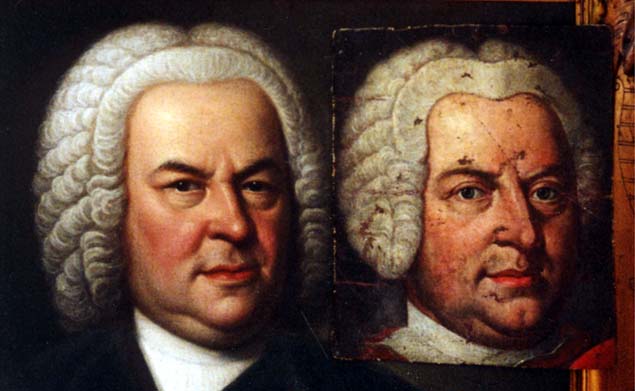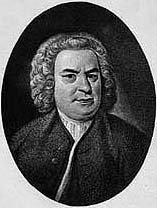The Present Day Misconceptions About Bach Performance Practice in the 19th Century - The Evidence of the Recordings Pages
at the Teri Noel Towe Home Pages - Page 6 - Footnotes
Johann Sebastian Bach
Present Day Misconceptions
About Bach Performance Practice in the Nineteenth Century
The Evidence of the Recordings
This remarkable photograph is not a computer generated composite; the original of the Weydenhammer Portrait Fragment, all that
remains of the portrait of Johann Sebastian Bach that belonged to his pupil Johann Christian Kittel, is resting gently on the surface
of the original of the 1748 Elias Gottlob Haussmann Portrait of Johann Sebastian Bach.

1748 Elias Gottlob Haussmann Portrait, Courtesy of William H. Scheide, Princeton, New Jersey
Weydenhammer Portrait Fragment, ca. 1733, Artist Unknown, Courtesy of the Weydenhammer Descendants
Photograph by Teri Noel Towe
©Teri Noel Towe, 2001, All Rights Reserved
PRESENT DAY MISCONCEPTIONS
ABOUT BACH PERFORMANCE PRACTICE IN THE NINETEENTH CENTURY
THE EVIDENCE OF THE RECORDINGS
Page 6
Footnotes
- The author would like to express his deepest gratitude to Seymour Benstock, Paul Brainard, Thomas L. Clear, Will Crutchfield, Keith
Hardwick, Gerhard Herz, Donald R. Hodgman, Nicholas Kenyon, Alfred Mann, Randolph Mickelson, Frederick Neumann, James R.
Oestreich, Joshua Rifkin, Michelle Saacks, Peter Wadland, and Seth B. Winner, without whose invaluable suggestions, assistance, and moral
support this article would not have been possible.
- Gerhard Herz, Johann Sebastian Bach in Zeitalter des Rationalismus under Frühromantik (Zürich, 1936); translated by Gerhard Herz and
Jan McLin Clayberg as Johann Sebastian Bach in the Age of Rationalism and Early Romanticism and included in Gerhard Herz, Essays on
J. S. Bach (Ann Arbor, Michigan, 1985), p.95
- Herz, Johann Sebastian Bach in the Age of Rationalism and Early Romanticism, included in Gerhard Herz, Essays on J. S. Bach (Ann Arbor,
Michigan, 1985), p.95
- Jo Vincent, soprano; Ilona Durigo, alto; Karl Erb, tenor (Evangelist); Louis van Tulder, tenor (arias); Willem Ravelli, bass (Jesus); Hermann
Schey, bass (arias), Amsterdam Toonkunst Choir; "Zanglust" Boys Choir; Amsterdam Concertgebouw Orkest; Willem Mengelberg,
conductor. Recorded in concert in the Concertgebouw, Amsterdam, on Palm Sunday, April 2, 1939. Columbia SL-179 (3 LPs); Philips
416-206-3 (3 CDs)
- I would like to express particular gratitude to Will Crutchfield, whose aid in determining the tempos was indispensable and whose suggestions
as to how to express them in words to reflect accurately the character of the various performances were invaluable.
- Berliner Philharmonischer Chor und Orchester, Siegfried Ochs, conductor. Grammophon EJ 195, two 12 inch 78 RPM sides.
- Elste, Martin, "Siegfried Ochs" in the New Grove Dictionary of Music (London, 1980), Vol. 13, p. 488
- Personal conversation, Hempstead, New York, October 26, 1985.
- Elizabeth Feuge, soprano; Margarete Klose, contralto; Koloman von Pataky (Evangelist and arias), Paul Schöffler, bass-baritone (Jesus);
Kurt Bõhme, bass (arias); Leipziger Universitätschor und Madrigalkreis; Knabenchor des Petrischule, Leipziger Symphonieorchester, Hans
Weissbach, conductor. Recorded in concert in the Altes Gewandhaus, Leipzig, on April 19, 1935. Acanta Bellaphon FA 23076 (3LPs)
- Personal conversation, Hempstead, New York, October 26, 1985.
- Slonimsky, Nicholas, "Hans Weisbach" in Baker's Dictionary of Music and Musicians (New York, 1971), p. 1774, and Supplement, p. 251;
Geiringer, Karl, "Hans Weisbach", Grove's Dictionary of Music and Musicians, 5th Edition, edited by Eric Blom (London and New York,
1954), Vol. 9, p. 246.
- Geiringer, Karl, "Hans Weisbach", Grove's Dictionary of Music and Musicians, 5th Edition, edited by Eric Blom (London and New York,
1954), Vol. 9, p. 246.
- Gramophone and Typewriter Company 047903 (Matrix Number 204y), a 12 inch 78 RPM disc, reissued on LP on Opal 804.
- Gramophone and Typewriter Company 047904 (Matrix Number 205y), a 12 inch 78 RPM disc, reissued on LP on Opal 804.
- Hanslick, Eduard, in an 1861 review of a performance of the Beethoven Violin Concerto, quoted by Roger Thomas Oliver in "Joseph
Joachim", New Grove Dictionary of Music (London, 1980), Vol. 9, pp 652-654, p. 653
- London Philharmonic Orchestra, Sir Adrian Boult, EMI SLS 866 (2LPs).
- Boult, Sir Adrian, "A Preface by Sir Adrian Boult", in the booklet to the EMI set SLS 866, p. 3.
- The Musical Times, Vol. 46 (1905), p. 41, quoted by John Warrack in "Fritz Steinbach" in the New Grove Dictionary of Music (London,
1980), Vol. 18, p. 107
- BBC Symphony Orchestra, Dr. Adrian Boult, conductor. His Master's Voice DB 1963 - DB 1965, Victor 11693 - 11695 in Album Set M-214,
five 12 inch 78 RPM sides.
- Royal Albert Hall Orchestra, Eugene Goossens, conductor. His Master's Voice D 683 and D 684 (Matrix numbers: Side 1: 3-8026,
Cc1935III; Side 2: 3-8027, Cc1936II; Side 3: 3-8028, Cc1937II), three 12 inch sides.
- Despite the practically identical metronome markings, there is a ten-second difference in the overall timings of the Boult and the Goossens
performances of the first movement. This discrepancy is accounted for by Goossens's having followed the then prevalent recording studio
convention of making a ritard before the side break mandated by the 78 RPM disc's relatively limited length.
- Berliner Philharmoniker, Wilhelm Furtwängler, conductor. Polydor 95417 and 95418; Brunswick 90161 and 90162. three 12 inch 78 RPM
sides.
- Spitta, Philipp, Johann Sebastian Bach, 3 vols. (Berlin, 1873, 1879, 1880); translated by Clara Bell and J. A. Fuller Maitland, (London, 1899),
Vol. 1, p. 446, footnote 150. In that footnote, Spitta mentions having shown the score of Nach dir Herr verlanget mich to Brahms, who offered
his opinion on what he thought must have been the correct original text to a particular passage in the copy that he had been shown. This event,
of course, took place prior to the publication in 1873 of the first volume of Spitta's biography, and thus a number of years before the
composition of the E Minor Symphony, Op. 98.
- Hamilton, David, "The Rake's Progress: A Novel Work Vividly Aware of its Past", Opus, Vol. 1, No. 6 (October, 1984), pp. 24-26, p. 26
- Philip, Robert, "The Recordings of Sir Edward Elgar -- Authenticity and Performance Practice", Early Music, Vol. 12, No. 4 (November,
1984), pp. 481-489, pp. 488-489.
1. The Traditional View of Bach Performance Practice in the Nineteenth Century
2. Siegfried Ochs and Hans Weisbach
3. Joseph Joachim
4. Sir Adrian Boult and Sir Eugene Goossens
5. Why An Understanding of What Nineteenth Century Bach Performance Practice Actually Was Is A Matter of Crucial Importance
at the Beginning of the Twenty-First Century
Please click on  to return to the Preface.
to return to the Preface.
Click on  to return to the Johann Sebastian Bach Index Page.
to return to the Johann Sebastian Bach Index Page.
Click on the  to return to the Teri Noel Towe Welcome Page.
to return to the Teri Noel Towe Welcome Page.
teritowe@alumni.Princeton.EDU
Copyright, Teri Noel Towe, 1985, 1986, 1988, 1989, 2001
All Rights Reserved
The Present Day Misconceptions About Bach Performance Practice in the Nineteenth Century - The Evidence of the Recordings
Pages at the Teri Noel Towe Home Pages
are PPP Free web pages.

The Present Day Misconceptions About Bach Performance Practice in the Nineteenth Century - The Evidence of the Recordings
Pages at the Teri Noel Towe Home Pages have received
the HIP Woolly Mammoth Stamp of Approval from The HIP-ocrisy Home Page.